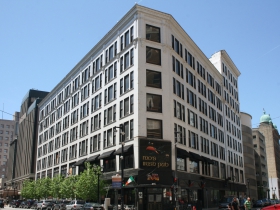State Freezes Historic Preservation Tax Credits
Worried about the cost, Gov. Walker and WEDC have halted program with big benefits for Milwaukee.
In March I reported on an important change to the state’s historic preservation tax credit program. The change significantly increased the value of the credits, encouraging developers to rehabilitate qualifying buildings in urban areas instead of pursuing (non-historic) greenfield development. The old credit of just 5 percent of the historic project’s value was doubled — to 10 percent — as part of the state budget and then doubled again — to 20 percent — in later legislation.
Speaking at an event in March on how to take advantage of the tax credit program, Draeger noted that his office had received $90 million in applications (with an estimated tax credit value $18 million). His speech was apparently so good that he managed to get another $90 million in applications. As of Monday, the state has approved approximately $180 million in projects, or $35 million in tax credits. In my earlier story I called the tax credit increase “a decidedly pro-city move by Republican Gov. Scott Walker and the legislature,” and sure enough, some $19 million of the $35 million in approved tax credits were for projects within the city of Milwaukee.
However, the Wisconsin Economic Development Corporation doesn’t see the big increase in historic preservation projects as all good news, nor does Walker. The WEDC has put the tax credits on hold, awarding a handful of projects credits on Monday before freezing the program. Turns out the state had only budgeted for $4 million in credits, leaving the WEDC $31 million short of the money needed to cover the tax credits awarded.
The Governor’s spokeswoman Laurel Patrick told Scott Bauer of the Associated Press that Walker favors the moratorium: “given high demand, putting a temporary halt to the program makes sense while the appropriate level of spending is studied for the next budget,” Patrick said. That wouldn’t be so bad if the next budget went into effect January 1st, 2015. Unfortunately the next biennial state budget isn’t slated to go into effect until the second half of 2015. The state will have emptied the pipeline for new projects for an entire year, assuming the program comes back at all. That’s a big blow to development in the city.
Here’s hoping it’s only a temporary setback. The Republican leaders of the Joint Finance Committee, Rep. John Nygren (R-Marinette) and Sen. Alberta Darling (R-River Hills) have both expressed support for the program and said they were looking forward to ways to make it viable.
Projects already approved (including the Posner Building, Milwaukee Paper Box Building and 700 W. Michigan St.) will continue to move forward, but things will dry up after that.
Approved Milwaukee Projects
- Posner Building, $4.2 million
- Pritzlaff Building, $4.1 million
- 731 N. Jackson St., $3.4 million
- Milwaukee Paper Box Building, $2.7 million
- Pfister Vogel Tannery building (The Tannery), $2.2 million
- 700 Lofts (700 W. Michigan St), $1.3 million
- Juneau Theatre/Mitchell Building (609 W. Mitchell St.), $335,600
- Johnson Controls office building, $275,871
- 1818 Martin Luther King Jr. Dr, $262,119
- Mitchell Building (207 E. Michigan St.), $240,000
- Best Place, $100,000
More background on the tax credit program is available in my article “Historic Preservation Goes Crazy” from March 28th, 2014.
Eyes on Milwaukee
-
Church, Cupid Partner On Affordable Housing
 Dec 4th, 2023 by Jeramey Jannene
Dec 4th, 2023 by Jeramey Jannene
-
Downtown Building Sells For Nearly Twice Its Assessed Value
 Nov 12th, 2023 by Jeramey Jannene
Nov 12th, 2023 by Jeramey Jannene
-
Immigration Office Moving To 310W Building
 Oct 25th, 2023 by Jeramey Jannene
Oct 25th, 2023 by Jeramey Jannene





















Maybe I don’t understand. If the old buildings sit dilapidated, isn’t the State out that money anyway?
Of course it would seem like this funding favors cities. Cities have higher densities of historic buildings. They also have higher population densities. It just makes sense that the cities would be a larger higher priority for pretty much anything.